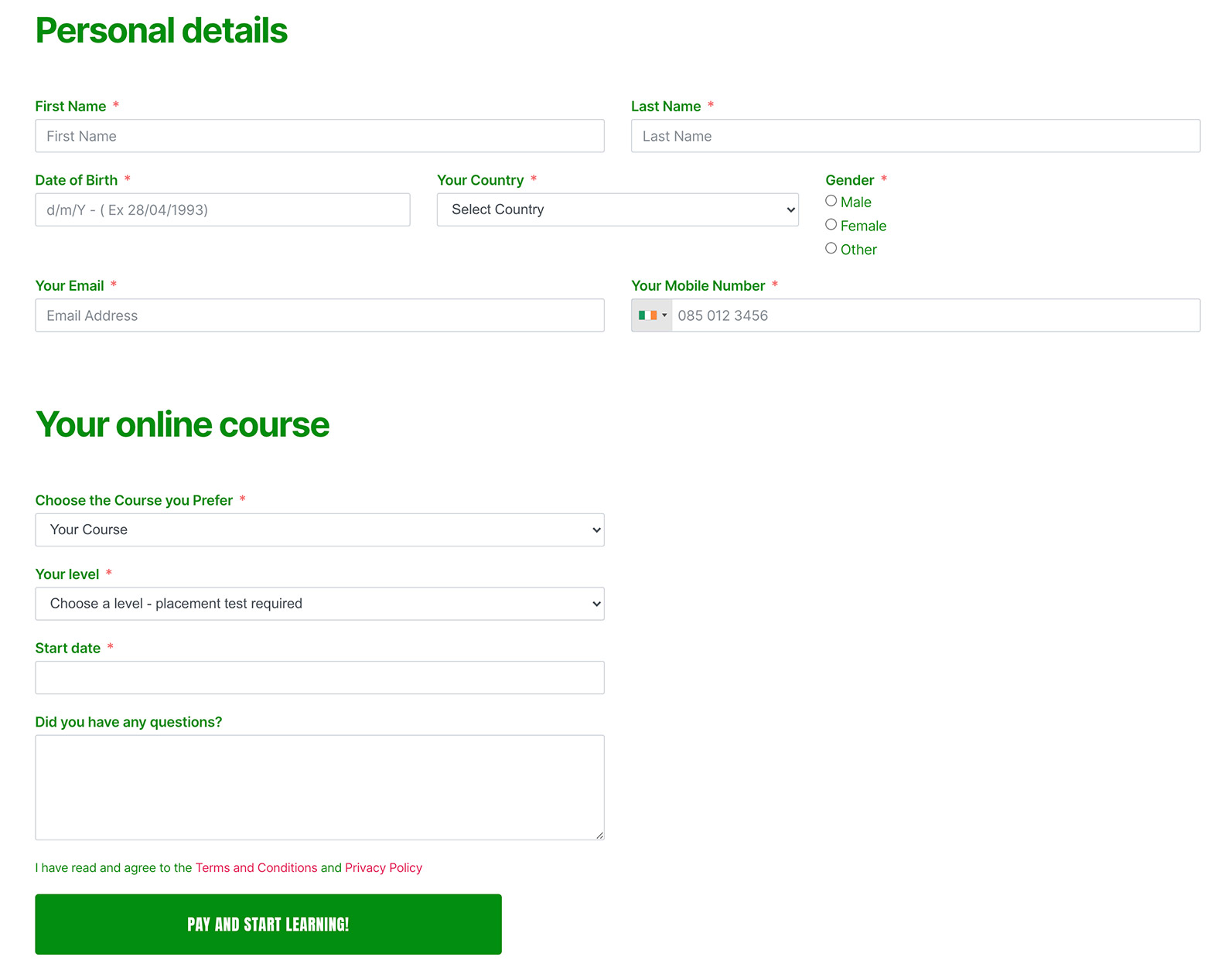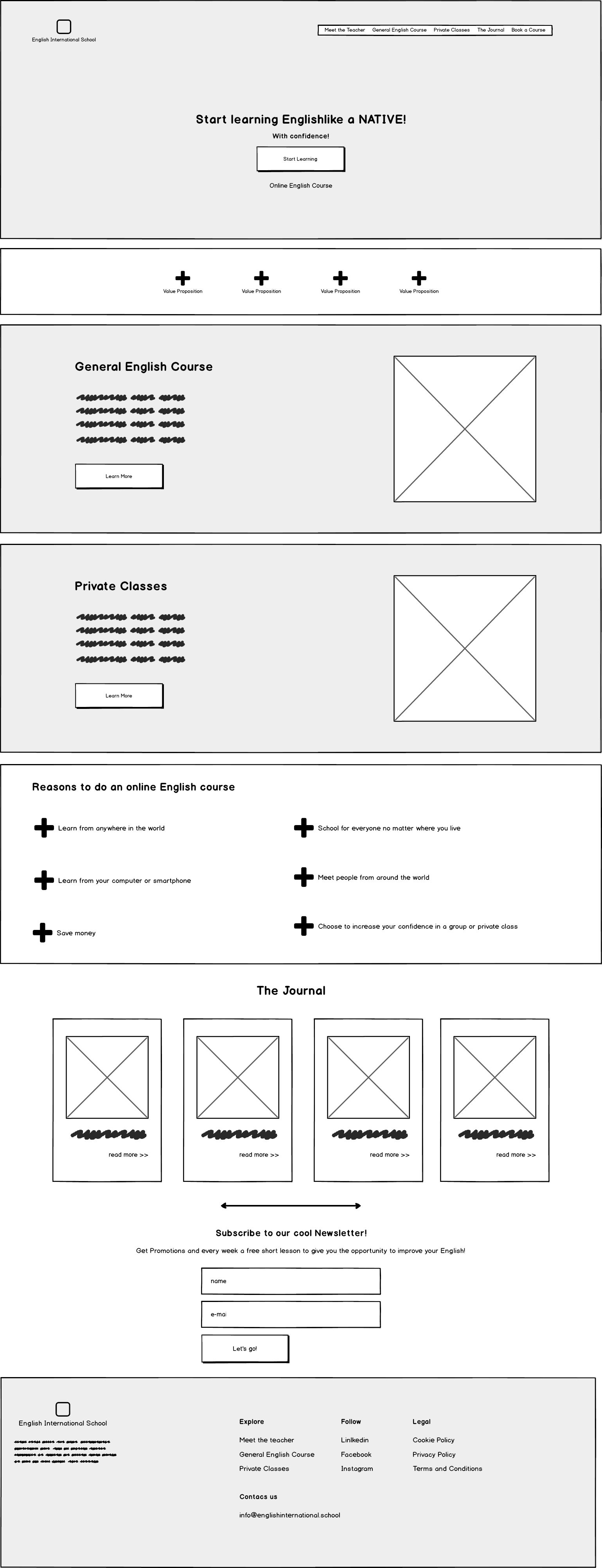Educational

case 3.

The English International School project emerged during the initial Covid lockdown in Ireland and it is actually my first true personal project, which I took on a few months after moving to this beautiful country. The idea came from several native-speaking teachers who wanted to open a fully online English school that could meet the students’ growing need for flexibility and ease of use.
In this case, the client had already independently developed an MVP based on a simple mini website, in which a calendar and payment button gave users the opportunity to book 3 or 6 months’ worth of Zoom classes at a truly competitive price.

A winning, sustainable, and successful product or service cannot only be cost effective. The main problem, from the very beginning, was identifying valuable ideas and propositions and aligning them with the stakeholders’ views and opinions: not an easy task, given the fact that the majority of them were not used to collaborative design activities.
Create a high visual impact and easy to use portal, especially in regard to the customer’s buying experience which, in this particular sector, is often cumbersome because tied to different steps and variables that make the service appear frustrating and unclear.




1 Project Manager / Product Designer
1 User Interface Designers
1 Front End Developer
1 Seo Copywriter
In collaboration with several English teachers
Given the limited budget, the project could sustain true and exhaustive user research (quantitative/qualitative).
In cases like this one, I propose a series of stakeholder workshops and activities in order to identify the classic problems that are normally encountered when defining a product/service.
It is interesting to note that the whole project was entirely designed and developed remotely.
Co-design activities were divided based on the relationship between requirements and objectives.
As an introductory and informational activity, it was necessary to ensure that all parties were on the same page.
Collaborating on the Miro platform created a productive sharing environment.

A classic Lean Ux framework created the conditions for an initial engagement among the parties, thanks to which we were able to start formulating hypotheses, specifically during this research phase.
It also provided a general and detailed view of the project.
Combined with the previous Canvas, it provided support to define key concepts as either strengths or weaknesses and especially to analyze the project from a more strategic perspective.
Punti di forza
Punti di debolezza
Being able to understand where, how, and in what respect to differentiate ourselves - and how to do it well - gave us a crucial advantage in certain areas.
The analysis was conducted based on the following criteria:
Social media position
Tone of voice
Type of services
Pricing strategy
Buying process
The small budget did not prevent the creation of a survey that was sent to the ex-students of the teachers participating in the project.
After collecting their information and classifying them by country of origin, we created the survey using Google Forms.
Gather the feedback of users who already attended a language course in a virtual setting.
Assess the strengths and weaknesses of said experiences to create differentiation and added value.
How would you value your overall experience in a virtual setting
Were the lessons the right length of time?
What would you consider an added value?
Is this an experience you would do again?
What improvements would you recommend?
Competitor analysis and survey results provided a series of valuable information for the purpose of making strategic and differentiating decisions in terms of product value.
Below are some relevant data:
Leadership acquired through professional experience ;
Content marketing strategy that ensured an excellent natural positioning ;
Multilingual customer care for some of them ;
Cumbersome buying process
time and dates to be determined with few options for rescheduling
Online classes are often crowded and distracting
+50% of users expressed the need to have longer lessons for better comprehension of the material.
+50% would like to have some time with the teacher at the end of each lesson to ask questions.
Those results helped us define value propositions that could differentiate us from the majority of our competitors:
Two-hour lessons and classes with a maximum of 8 participants.
Card sorting
Website categorization activities were performed through a simple card sorting workshop.
Some of the feedback was already in our possession from the competitor analysis that we previously conducted.
The result was an extremely simple and clear navigation experience with almost no depth.
Our competitor analysis allowed us to move in a different direction in regard to booking courses.
Most of our competitors, in fact, don’t offer the option to fully complete the purchase in one step, due to multiple applicable variables.
The final result is a disjointed, labor-intensive, and cumbersome process.
Some of the variables (excluding personal information):
We therefore created a reservation and purchase form with conditional and sequential fields that could guide the user in choosing the ideal solution. We then automated and simplified all processes so that the oral entrance test could be booked by video call and the written one by browser, with no interruptions.

Based on the work performed up to that point, we developed an initial rough draft of the homepage.

The high fidelity prototype was created with Adobe XD and, thanks to effective co-design efforts, its development proved quite simple and straightforward.
As of now, the project has been online for a few months.The content marketing strategy is starting to bear results thanks to a process of differentiation and expansion on the three channels currently used: Facebook, Instagram and Linkedin. It is interesting to point out how all of this was achieved with a really small advertising budget, proof of the project quality.
The English International School project offered me the opportunity to reflect on the role of design thinking in small business.It is interesting to come to the realization that design thinking is actually a completely malleable and adaptable tool, especially in contexts where timing and budget are quite limited.I have always considered small business as the greatest challenge for us designers. Trying to convey the value of a “thoughtfully designed” project is a duty before being a need. More exactly, we should reflect further on the frameworks, methodologies, and processes commonly used in planning and design, and ensure that they don’t become an exclusive prerogative of larger companies that can sustain that kind of activity.